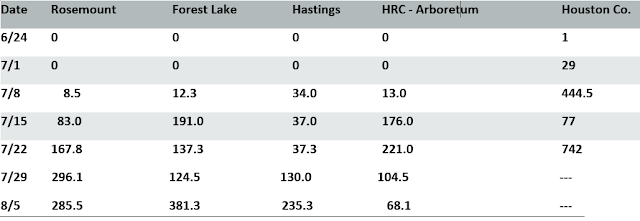Authors: Bill Hutchison, Eric Burkness, Anh Tran, Dominique Ebbenga & Suzanne Wold-Burkness
MN Extension IPM Program, Dept. of Entomology, University of Minnesota, St. Paul campus
Spotted-wing Drosophila (SWD) trap catches continue to remain very high in all on-farm and research locations monitored, especially the past 2 weeks. Traps in our network are effective at catching both male and female flies (Fig. 1). See Table 1 below for details. Growers should remain diligent in alternating insecticide products as much as possible (e.g. Delegate or Entrust (organic-certified) and Mustang Maxx, and malathion if needed), and follow the pre-harvest intervals noted on the label for each product.
An additional reason for the concern with high SWD numbers in traps is not only for the SWD catch within berry crops, but also the concern with the SWD “reservoir” confirmed again this summer in nearby forested areas or “tree lines” that often occur near berry fields.
Traps are checked on Mondays, with the SWD trap page usually updated by Wednesday afternoon each week. To stay up to date on the SWD situation, view the complete SWD Trap Network data at: https://www.fruitedge.umn.edu/swdtrap . The trap catch network is based on our use of the Scentry Trap design (Fig. 2) and 4-component lure; data are summarized on Fruitedge by date and berry crop.
MN Extension IPM Program, Dept. of Entomology, University of Minnesota, St. Paul campus
Spotted-wing Drosophila (SWD) trap catches continue to remain very high in all on-farm and research locations monitored, especially the past 2 weeks. Traps in our network are effective at catching both male and female flies (Fig. 1). See Table 1 below for details. Growers should remain diligent in alternating insecticide products as much as possible (e.g. Delegate or Entrust (organic-certified) and Mustang Maxx, and malathion if needed), and follow the pre-harvest intervals noted on the label for each product.
 |
| Table 1. Average weekly SWD trap catch, as of August 5, 2019, for several locations in southern MN. |
An additional reason for the concern with high SWD numbers in traps is not only for the SWD catch within berry crops, but also the concern with the SWD “reservoir” confirmed again this summer in nearby forested areas or “tree lines” that often occur near berry fields.
Our previous sampling has shown that during the heat of July-August, we will catch more SWD flies in the shaded tree-line areas vs the berry field. This has been evident again this week, where we trapped at both Rosemount and the Forest Lake locations. For example, Rosemount averaged 285.5/week in fall raspberry (Table 1) but 1,166/week in the nearby tree-line. Likewise at Forest Lake, SWD averaged 381.3/week in raspberry and blueberry, but reached a record 8,954/week in the nearby tree-line. It is well known from both high-tunnel studies with poly, and laboratory studies, that SWD does not prefer hot weather, with reproductive activity slowing at about 85 degrees F. So, at least there is some good news with the recent warmer weather, but nevertheless this underscores the major challenge we have in controlling this pest in open field situations.


Comments
Post a Comment